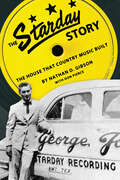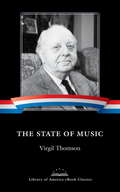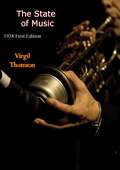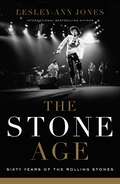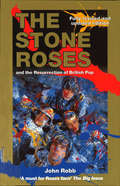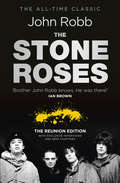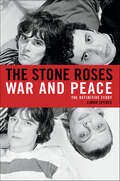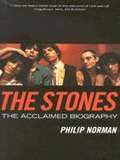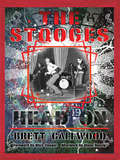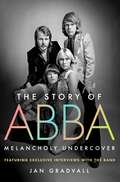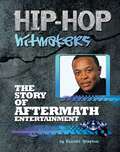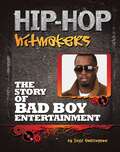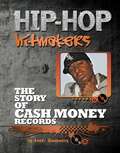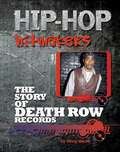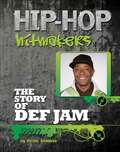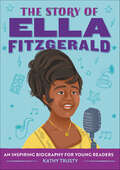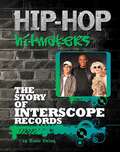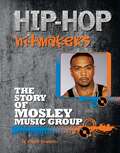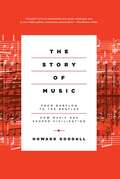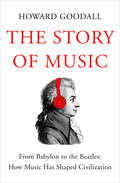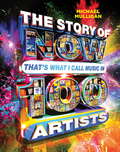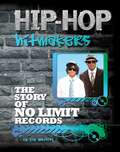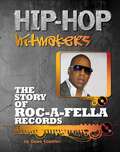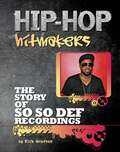- Table View
- List View
The Starday Story: The House That Country Music Built (American Made Music Series)
by Nathan D. GibsonAssociation of Recorded Sound Collections Awards for ExcellenceBest Research in Record Labels–Certificate of Merit (2012)The Starday Story: The House That Country Music Built is the first book entirely dedicated to one of the most influential music labels of the twentieth century. In addition to creating the largest bluegrass catalogue throughout the 1950s and '60s, Starday was also known for its legendary rockabilly catalogue, an extensive Texas honky-tonk outpouring, classic gospel and sacred recordings, and as a Nashville independent powerhouse studio and label.Written with label president and co-founder Don Pierce, this book traces the label's origins in 1953 through the 1968 Starday-King merger. Interviews with artists and their families, employees, and Pierce contribute to the stories behind famous hit songs, including "Y'all Come," "A Satisfied Mind," "Why Baby Why," "Giddy-up Go," "Alabam," and many others. Gibson's research and interviews also shed new light on the musical careers of George Jones, Arlie Duff, Willie Nelson, Roger Miller, the Stanley Brothers, Cowboy Copas, Red Sovine, and countless other Starday artists. Conversations with the children of Pappy Daily and Jack Starns provide a unique perspective on the early days of Starday, and extensive interviews with Pierce offer an insider glance at the country music industry during its golden era.Weathering through the storm of rock and roll and, later, the Nashville Sound, Starday was a home to traditional country musicians and became one of the most successful independent labels in American history. Ultimately, The Starday Story is the definitive record of a country music label that played an integral role in preserving our nation's musical heritage.
The State of Music
by Virgil ThomsonVirgil Thomson had already established himself as one of the nation's leading composers when he published The State of Music (1939), the book that made his name as a writer and won him a fourteen-year stint as chief music reviewer at the New York Herald Tribune. This feisty, often hilarious polemic, presented here in the extensively revised edition of 1962, surveys the challenges confronting the American composer in a hide-bound world where performance and broadcast outlets are controlled by institutions shocked by the new and suspicious of homegrown talent. For Aaron Copland, The State of Music was not just "the most original book on music that America has produced," but "the wittiest, the most provocative, the best written."
The State of Music: 1938 First Edition
by Virgil ThomsonComposer Thomson, whose film score for Louisiana Story was awarded the Music Pulitzer Prize in 1949, writes about contemporary music and a musician's place in society before World War II.-Print ed.
The Stone Age: Sixty Years of The Rolling Stones
by Lesley-Ann JonesAn acclaimed rock and roll journalist evokes the legacy of The Rolling Stones—iconic, granitic, commercially unstoppable as a collective; and fascinating, contradictory, and occasionally disturbing as individuals.As Lesley-Ann Jones writes, the Rolling Stones are "still roaming the globe like rusty tanks without a war to go to. Jumping, jacking, flashing, posturing, these septuagenarian caricatures with faces that might have been microwaved but coming on like eternal thirty-year-olds.&” On 12th July 1962, the Rollin&’ Stones performed their first-ever gig at London&’s Marquee jazz club. Down the line, a &‘g&’ was added, a spark was lit and their destiny was sealed. No going back. These five white British kids set out to play the music of black America. They honed a style that bled bluesy undertones into dark insinuations of women, sex, and drugs. Denounced as &‘corruptors of youth&’ and &‘messengers of the devil,&’ they created some of the most thrilling music ever recorded. Now their sound and attitude seem louder and more influential than ever. Elvis is dead and the Beatles are over, but Jagger and Richards bestride the world. The Stones may be gathering moss, but on they roll. Yet how did the ultimate anti-establishment misfits become the global brand we know today? Who were the casualties, and what are the forgotten legacies? Can the artist ever be truly divisible from the art? Lesley-Ann Jones&’s new history tracks this contradictory, disturbing, granitic and unstoppable band through hope, glory and exile, into the juggernaut years and beyond into rock&’s ongoing reckoning . . . where the Stones seem more at odds than ever with the values and heritage against which they have always rebelled. Good, bad, and often ugly, here are the Rolling Stones as never seen before.
The Stone Roses And The Resurrection Of British Pop: The Reunion Edition
by John RobbThe band, the lifestyle, the revolution. This classic biography charts the phenomenal rise of The Stone Roses to the icons they are today, using interviews, rehearsal tapes and the archives of author John Robb who was with them from the beginning.Robb's exclusive inside knowledge of The Stone Roses creates a compelling and intimate insight into how the band single-handedly set the blueprint for the resurgence of UK rock 'n' roll in the 1990s: Ian Brown's new lazy-style vocals, Reni's fluid, funk-tinged, ground-breaking drumming, and the guitar genius of John Squire. From the band members' early years to the inception of the Roses, through the tours and success, their influences and style, to the demise of the original line-up and their solo careers; every high and low is documented in minute detail.This is the definitive, most revered account of one of the most influential British bands in pop music history.
The Stone Roses And The Resurrection of British Pop: The Reunion Edition
by John Robb'The Stone Roses have become folk heroes, frozen in time. And their story, with roots in punk through post-punk, scooter boys, skinheads, Northern Soul, psychedelia, acid house and Madchester, is everything that is great about British street culture.'Reni. Mani. Ian Brown. John Squire.Names that will forever be remembered for creating their defining album The Stone Roses and a unique but inimitable baggy style.Their phenomenal story was first documented by the man who was with them every step of the way: John Robb. And now, in this special edition of his acclaimed and intimate biography, Robb brings the ultimate rock 'n' roll tale fully up to date.
The Stone Roses: War and Peace: The Definitive Story
by Simon SpenceThe Stone Roses captures the magic—and chaos—behind the UK band's rise, fall, and recent resurrection.The iconic Brit pop band The Stone Roses became an overnight sensation when their 1989 eponymous album went double platinum. It was a recording that is still often listed as one of the best albums ever made. Its chiming guitar riffs, anthemic melodies, and Smiths-like pop sensibility elevated The Stone Roses to a cult-like status in the UK and put them on the map in the U.S. But theirs is a story of unfulfilled success: their star imploded as their sophomore effort took years to complete and the band broke up acrimoniously in 1996. Sixteen years later, they reunited and have been playing sold out gigs, thrilling fans around the globe, and working on new material. In 2013, they nabbed the coveted headline spot at the Coachella Festival. With one hundred interviews of key figures, forty rare photographs, and exclusive insider material including how they created their music, The Stone Roses charts the band's rise from the backwaters of Manchester to becoming the stars of the "Madchester" scene to their successful comeback years later. Going beyond the myths to depict a band that defined Brit pop, Simon Spence illustrates their incandescent talent and jaw-dropping success while contextualizing them in the 90s music scene. This is the definitive story of The Stone Roses.
The Stones
by Philip Norman'Details their amazing career and lifestyle ... the tours that saved them from bankruptcy, the drug raids, the mysterious death in his own swimming pool of Brian Jones and the suicide attempt of Marianne Faithfull. After reading this account one can't help but marvel that they have survived'
The Stooges: Head On
by Alice Cooper Brett Callwood Glen DanzigThe story of seminal Ann Arbor punk rock band the Stooges, told through original interviews with the band members and associates.
The Story of ABBA: Melancholy Undercover
by Jan GradvallThrough exclusive interviews and over a decade of deep research, renowned music journalist Jan Gradvall explores the secrets to ABBA’s success.There has never been a group like ABBA. More than half a century after their songs were recorded, ABBA still make people the world over dance and sing their hearts out. In 2013, when the band had not been interviewed for over thirty years, Jan Gradvall was granted unique access to them for the next decade and the result is The Story of ABBA: Melancholy Undercover. Agnetha Fältskog, Björn Ulvaeus, Benny Andersson, and Anni-Frid Lyngstad all share their personal stories, their thoughts and their opinions about ABBA’s music more openly than ever before. Weaving in and out of their story, well-known international music critic Jan Gradvall reveals the context in which their unique sound developed and shows how the story of ABBA is also the story of Sweden and the globalization of pop culture.From their earliest hits in Sweden like “People Need Love” and “Ring, Ring” to their chart-topping international hits like “Dancing Queen,” “Gimme, Gimme, Gimme” and “Mama Mia!” to ABBA Voyage – their first album in forty years – and the two-million-ticket-selling eponymous concert-experience in London, it is undeniable that, in the history of pop culture and music, there has never been a group like ABBA. With remarkable intimacy, Gradvall’s sensational book brings readers closer than ever to one of the world’s most notoriously private groups.
The Story of Aftermath Entertainment (Hip-Hop Hitmakers)
by Robert GraysonDr. Dre was the face of hip-hop by the time he started Aftermath Entertainment in 1996. But like any new record label, even one started by a legend, Aftermath had to go through some growing pains before finding its sound. Once it did, Aftermath was on a roll, producing platinum albums by megastars like Eminem and 50 Cent. The record label combined the creativity and fresh material of new rap stars with the special touch only a musical genius like Dr. Dre could add. Born out of the violent era of the West Coast-East Coast rap feud, Aftermath carried Dr. Dre's hopes of creating a record label that focused solely on music, not violence. There were some false starts along the way. But it did not take Aftermath long to introduce some of rap's biggest names to the world and sell millions upon millions of albums.
The Story of Bad Boy Entertainment (Hip-Hop Hitmakers)
by Jeff BurlingameThe story of Bad Boy Entertainment is one of triumph and tragedy. It was triumph when the dream of founder Sean "Puffy" Combs was transformed into one of the most successful record labels in the history of hip-hop music. It was tragedy when the life of Bad Boy's most successful artist, Christopher "Biggie" Wallace, was violently ended at the prime of his career. It was triumph again when Puffy evoked Biggie's memory in a chart-topping song that helped jump-start a highly successful performing career of his own. Nearly 20 years after its founding, Bad Boy Entertainment has grown from a record label spinning out rap hits to a do-everything company with dealings in the world of fashion, food, and music.
The Story of Cash Money Records (Hip-Hop Hitmakers)
by Terri DoughertyFounded in New Orleans in the early 1990s, Cash Money Records faced an uphill battle as it struggled to gain respect. Brothers Bryan "Baby" Williams and Ronald "Slim" Williams started the label by recording New Orleans artists who were part of the local " bounce music" scene. The label's young rappers, including Juvenile, B.G., and Turk, worked hard to deliver hits, but inner turmoil almost derailed Cash Money's success. The breakout success of Lil Wayne, who became the label's biggest star and even served as its president for a time, helped Cash Money survive during a difficult decade. Today stars like Drake and Nicki Minaj are helping to make Cash Money Records a household name in the hip-hop world.
The Story of Death Row Records (Hip-Hop Hitmakers)
by Trey WhiteFor a few years in the mid-1990s, a small music label called Death Row stood atop the hip-hop world. Death Row Records was instrumental in introducing a hard-core style of rap music known as "gangsta rap" to mainstream audiences. Albums like Dr. Dre's The Chronic, Snoop Doggy Dogg's Doggystyle, and Tupac Shakur's All Eyez on Me sold millions of copies and influenced a new generation of artists. The money rolled in for Death Row's founder, Marion "Suge" Knight. The good times could not last, however. Tupac was murdered, Suge Knight was sent to prison for various crimes, and the label's top stars moved on. The dramatic rise and fall of Death Row Records is chronicled in this book.
The Story of Def Jam (Hip-Hop Hitmakers)
by Brian BaughanWhen it was founded in 1984, Def Jam was a tiny operation nestled in the college dorm room of Rick Rubin. He and promoter Russell Simmons quickly built a music empire around a talented crew of groundbreaking artists and an allegiance to the "real street music" that was about to bust out of New York City's hip-hop circles. Over the course of several decades, Def Jam has helped launched many of the best acts in rap and pop music, including LL Cool J, the Beastie Boys, Public Enemy, Method Man, DMX, Ja Rule, Jay-Z, and Rihanna. Over 200 gold and over 70 platinum records bear the Def Jam label. Def Jam's 25th anniversary in 2009 was just another milestone in the story of a label that helped define the sound as well as the wider culture of hip-hop.
The Story of Ella Fitzgerald: An Inspiring Biography for Young Readers (The Story of Biographies)
by Kathy TrustyDiscover the life of Ella Fitzgerald—a story about finding your voice for kids ages 6 to 9 Ella Fitzgerald was one of the greatest singers of all time. Before she found her voice and changed the world of jazz music, she was a playful girl who wanted to become a dancer. Her life changed when people started noticing her beautiful singing voice, and she was hired as a singer in a famous jazz band. Explore how Ella went from being a young girl growing up in New York to an award-winning artist who made musical history.Independent reading—This Ella Fitzgerald biography is broken down into short chapters and simple language so kids 6 to 9 can read and learn on their own.Critical thinking—Kids will learn the Who, What, Where, When, Why, and How of Ella's life, find definitions of new words, discussion questions, and more.A lasting legacy—Find out how Ella's impact on music and culture is still felt today.How will Ella's persistence and incredible talent inspire you?Discover activists, artists, and athletes, and more from across history with the rest of The Story Of series - including famous figures like: Katherine Johnson, Simone Biles, Jackie Robinson, Maya Angelou, and Michelle Obama.
The Story of Interscope Records (Hip-Hop Hitmakers)
by Diane BaileyHip-hop started on the streets of New York with African American youths in the 1970s. But with its strong beats and raw lyrics, it quickly spread across the country. It became the music of a generation of young Americans. But hip-hop is more than just music. It's a lifestyle. It's also big business. When Interscope Records was formed in 1990, the company's founders saw an opportunity. Young people loved the energy of hip-hop. Interscope gave rappers like Eminem and 50 Cent their start--and it paid off. Today, Interscope is a multimillion-dollar company that handles all kinds of music. There were setbacks on the way to success. But whether it was Lady Gaga or the Black Eyed Peas, Interscope always managed to find a star!
The Story of Mosley Music Group (Hip-Hop Hitmakers)
by Emma KowalskiSince the mid-1990s, Tim Mosley--better known as Timbaland--has been one of the most in-demand and critically respected producers in the music industry. His credits include numerous hits in hip-hop, as well as dance, R&B, pop, and rock. But that isn't the only contribution Timbaland has made to the music scene. In 2006, he became the CEO of his own record label, Mosley Music Group. Open to all kinds of acts, the label is part of, and distributed by, Interscope Records. Mosley Music Group has released several star-studded albums. The label has given new creative outlets to experienced artists like Nelly Furtado and Chris Cornell, and helped launch the careers of artists like OneRepublic, Keri Hilson, D.O.E., and MC Hayes. This book profiles all of Mosley Music Group's past and present artists and their releases, as well as the fascinating story of Timbaland's long and influential career.
The Story of Music
by Howard GoodallWhy did prehistoric people start making music? What does every postwar pop song have in common? A &“masterful&” tour of music through the ages (Booklist, starred review). Music is an intrinsic part of everyday life, and yet the history of its development from single notes to multi-layered orchestration can seem bewilderingly specialized and complex. In his dynamic tour through 40,000 years of music, from prehistoric instruments to modern-day pop, Howard Goodall does away with stuffy biographies, unhelpful labels, and tired terminology. Instead, he leads us through the story of music as it happened, idea by idea, so that each musical innovation—harmony, notation, sung theater, the orchestra, dance music, recording, broadcasting—strikes us with its original force. He focuses on what changed when and why, picking out the discoveries that revolutionized man-made sound and bringing to life musical visionaries from the little-known Pérotin to the colossus of Wagner. Along the way, he also gives refreshingly clear descriptions of what music is and how it works: what scales are all about, why some chords sound discordant, and what all post-war pop songs have in common. The story of music is the story of our urge to invent, connect, rebel—and entertain. Howard Goodall's beautifully clear and compelling account is both a hymn to human endeavor and a groundbreaking map of our musical journey.
The Story of Music: From Babylon to the Beatles: How Music Has Shaped Civilization
by Howard GoodallMusic is an intrinsic part of everyday life, and yet the history of its development from single notes to multi-layered orchestration can seem bewilderingly complex.In his dynamic tour through 40,000 years of music, from prehistoric instruments to modern-day pop, Howard Goodall leads us through the story of music as it happened, idea by idea, so that each musical innovation--harmony, notation, sung theater, the orchestra, dance music, recording--strikes us with its original force. Along the way, he also gives refreshingly clear descriptions of what music is and how it works: what scales are all about, why some chords sound discordant, and what all post-war pop songs have in common.The story of music is the story of our urge to invent, connect, rebel--and entertain. Goodall's beautifully clear and compelling account is both a hymn to human endeavor and a groundbreaking map of our musical journey.
The Story of NOW That's What I Call Music in 100 Artists
by Michael MulliganEveryone remembers their first NOW album. Since NOW That's What I Call Music Volume 1 was released in 1983 on double vinyl and double cassette, NOW has become synonymous with pop music and has featured some of the most iconic artists of the last three decades. To celebrate the release of the 100th NOW album, The Story of NOW That's What I Call Music in 100 Artists looks back at some of the most memorable - and occasionally regrettable - hits of the last 35 years! Jam packed with amazing facts and 'Well I never!' moments about the 4,000+ artists to have graced the NOW track listings - from Phil Collins to Pharrell, Bananarama to Lady Gaga and Peter Andre to Pet Shop Boys - The Story of NOW is a celebration of pop music through the decades. So plug in your earphones and pump up the volume, because this party is just getting started!
The Story of No Limit Records (Hip-Hop Hitmakers)
by Jim WhitingPercy "Master P." Miller came out of one of the toughest slums in New Orleans to found No Limit Records in Richmond, California, on a shoestring budget in 1991. Master P sold his first releases out of the trunk of his car, but he always believed in himself. Thanks to his hard work, within a few years No Limit was one of the most successful hip-hop record labels in the country and Master P was a multi-millionaire. Master P couldn't maintain this level of success, however, and in 2003 the label went bankrupt. Master P began a new label and kept going. In recent years, he has attempted to change the focus of his music to make it more positive, and started Take a Stand Records for that purpose. Now calling himself P. Miller, the rapper/entrepreneur remains active in the music business and also works to help others.
The Story of Roc-A-Fella Records (Hip-Hop Hitmakers)
by Emma KowalskiWhen Shawn Carter, an aspiring rapper with the stage name Jay-Z, couldn't get his career off the ground at a major record label, he didn't get discouraged. He and his partners Damon Dash and Kareem "Biggs" Burke created a hip-hop label of their own. They named the label Roc-A-Fella Records. Originally intended as a one-time project to release Jay-Z's full-length debut album, Reasonable Doubt, Roc-A-Fella Records expanded into a true hip-hop powerhouse. Roc-A-Fella Records has introduced listeners to the unique talents of artists like Kanye West, the Young Gunz, and the State Property crew. Other artists, such as Jadakiss and the O.D.B., have received another chance to kick-start their careers. This book describes the musical contributions of Jay-Z, Kanye West, and Roc-A-Fella's other past and present artists, as well as the record label's complex behind-the-scenes history.
The Story of So So Def Recordings (Hip-Hop Hitmakers)
by Rich MintzerDuring the early 1990s, successful music producer Jermaine Dupri started So So Def Records. The Atlanta-based label began at a time when Southern hip-hop music was just beginning to get a lot of attention. Dupri signed distribution deals with much-larger record companies like Columbia and Arista. This allowed him to focus on what he did best: finding talented unknown artists and producing hit music. Some of So So Def's biggest stars included Da Brat, Lil Bow Wow, and Jagged Edge. Today So So Def Records is completely independent, and Jermaine Dupri is working hard to introduce a new generation of hip-hop stars.
The Story of Stevie Wonder
by James HaskinsA biography of the blind composer, pianist, and singer who was a child prodigy and went on to win nine Grammy awards.<P><P>Winner of the Coretta Scott King Medal
